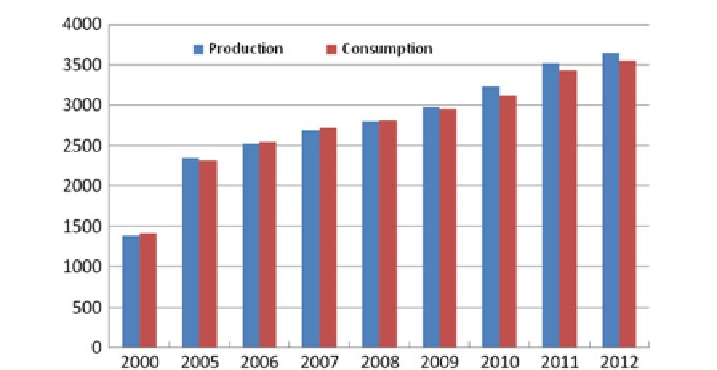Environmental Engineering Reference
In-Depth Information
Fig. 4.1
Production and consumption of China's raw coal (Mt) (Resource: National Bureau
of Statistics of China)
processing and conversion as well as high energy-consuming industries. In 2010,
there is 1.76 billion ton coal used for power generation, accounting for 53.3 % of
the total consumption. Three high energy-consuming industries including steel,
building material and chemical industry, altogether consume 1.16 billion ton coal,
accounting for 35 % of the total consumption.
4.1.2.2 Oil
For the past few years, China has witnessed a strong growth in its demand on crude
oil. In 2012, crude oil consumption reached 480 million ton, which more doubled
that in 2000 [
6
]. With an average annual growth rate in the late 10 years of 7 %, now
China has become the second largest oil consumer in the world. Due to small
quantity of crude oil resource, growth rate of crude oil production is not large with
only 2 % in the same period. In 2012, production of crude oil in China is 207 million
ton, topping world No. 5 (see Fig.
4.2
) . Since China became oil importing country
in 1993, China enjoys a continuous rise in net oil import volume and a constant
increase in its dependence on foreign countries. In 2012, degree of its oil depen-
dence on foreign countries reached 56 %.
4.1.2.3 Natural Gas
Compared with resource endowments, natural gas constitutes a small part in
China's primary energy production structure. Yet, in recent years, the production
appears to blowout. In 2012, China's natural gas production reached 107 billion
cubic meter, increasing by 2.9 times than that of 2000 with an annual growth rate
of 12 % (see Fig.
4.3
)[
6
]. In primary energy consumption structure, the proportion
of natural gas is still on the rise. However, domestic natural gas is not able to meet
the requirement and import volume began to increase year by year. In 2012, China
net natural gas import volume is 44.2 billion cubic meter.

